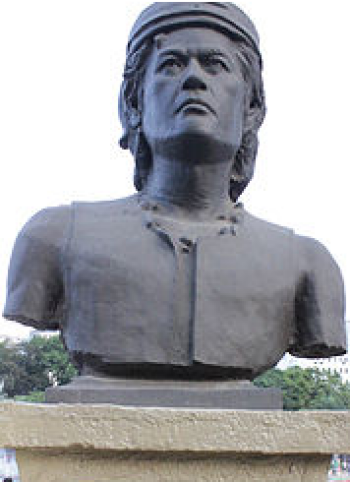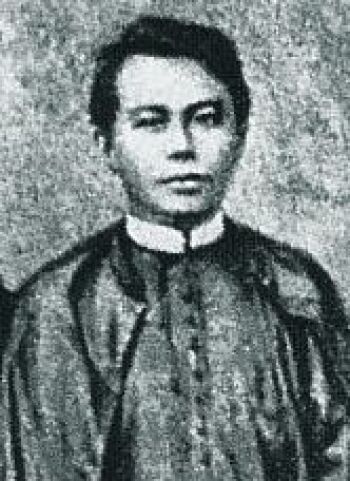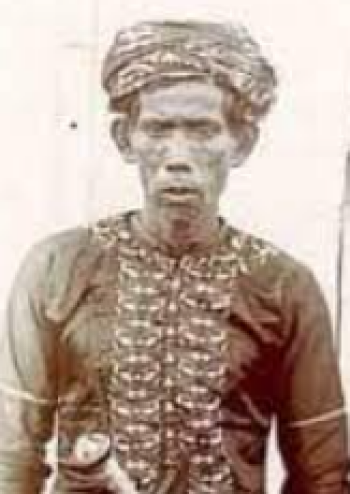Religion: Religious Leaders Pre-1900
Makhdum Karim (circa 14th century)
Religion and Branch: Sunni Islam (Sufism)
Title: Missionary, Mystic, Founder of Sheik Karimal Makdum Mosque
Makhdum Karim, also known as Karim ul-Makhdum, was an Arab Sufi Muslim and one of the earliest known Islamic missionaries to arrive in the Philippines.
Karim is believed to have arrived in the Philippines in the 14th century, specifically on the island of Sulu. He is one of the pioneering figures in introducing and propagating Islam in the southern part of the Philippine archipelago.
Recognized as the oldest mosque in the Philippines, Sheikh Karimal Makdum Mosque was built in 1380 in Simunul, Tawi-Tawi. It stands as a testament to the early Islamic influence in the region. The mosque is named in honor of Karim.
Karim's arrival and establishment of a place of worship marked the beginning of the institutionalization of Islam in the region. Over the years, Islam spread from Sulu to other parts of the Mindanao region, thanks in part to the foundational efforts of figures such as him.
Karim's influence and presence are still commemorated today in the Tubig-Indangan area in Simunul, where the historical mosque stands. Some pillars of the original mosque still exist, bearing silent witness to the beginnings of Islam in the country.
Karim played a pivotal role in the introduction and establishment of Islam in the southern Philippines. His legacy, encapsulated in the Sheikh Karimal Makdum Mosque, underscores the long history and deep roots of Islam in the country, particularly in the Sulu and Mindanao regions.
Francisco Blancas de San José (circa 1556-1614)
Religion and Branch: Christianity (Catholicism)
Title: Dominican Friar, Preacher, Missionary
Francisco Blancas de San José was a Spanish Dominican friar and missionary who played a significant role in the early propagation of Christianity in the Philippines. He belonged to the Order of Preachers, commonly known as the Dominicans. The Dominicans were one of the primary religious orders involved in the evangelization of the Philippines, alongside the Jesuits, Augustinians, and Franciscans.
Born in Tarazona, Spain, Blancas arrived in the Philippines in 1595. He was part of the initial wave of missionaries who worked to convert the indigenous populations of the Philippines to Christianity.
Beyond his evangelization efforts, Blancas is also remembered for his contributions to Philippine literature. He wrote the first poetic drama in Tagalog, which became instrumental in introducing Christian teachings to the Tagalog-speaking natives.
As with many early missionaries in the Philippines, Blancas' influence was not just religious but also cultural. His works played a crucial role in intertwining Christianity with Filipino culture, a fusion that remains evident to this day.
Blancas, with his missionary zeal and literary contributions, significantly impacted the religious and cultural landscape of the Philippines during the early period of Spanish colonization. His efforts laid foundational blocks for the deep-rooted Catholicism that characterizes the Philippines today.
Muhammad Dipatuan Kudarat (1581-1671)

Religion and Branch: Islam
Title: Sultan of Maguindanao
Muhammad Dipatuan Kudarat, commonly known as Sultan Kudarat, was a powerful and influential sultan of Maguindanao in the southern Philippines during the 17th century. Reigning from 1619 until his death in 1671, his influence extended over the seas of Mindanao, the Sulu archipelago, North Borneo, and neighboring islands.
Kudarat was a staunch defender of Islam in the region. By the time of his rule, Islam had already been established in various parts of the Mindanao island for centuries, especially among the Maguindanao and Maranao ethnic groups. Sultan Kudarat's reign is often characterized by his efforts to consolidate Muslim dominance in the region.
Kudarat successfully resisted Spanish attempts to colonize Mindanao and convert its inhabitants to Christianity. Under his leadership, Maguindanao became a formidable power that deterred Spanish invasion for several decades. His successful defense against the Spanish was, in part, driven by his desire to protect and preserve the Islamic faith in the region.
Kudarat's legacy as a defender of Islam against colonial forces is still remembered and celebrated today. He is regarded as one of the greatest Muslim rulers in the southern Philippines. The province of Sultan Kudarat in Mindanao is named in his honor.
Aside from military resistance, Kudarat also used diplomacy to secure his domain and the influence of Islam. He forged alliances with neighboring Muslim leaders, ensuring a united front against common threats.
Sultan Kudarat played a pivotal role in defending and preserving the Islamic faith in the southern Philippines during a time of significant external threat. His leadership was instrumental in resisting Spanish attempts to dominate and convert Mindanao, allowing the Muslim communities there to maintain their religious and cultural practices.
Lorenzo Ruiz (1594-1637)
Religion and Branch: Christianity (Catholicism)
Title: Martyr, Saint
Lorenzo Ruiz is a significant figure in the religious history of the Philippines, recognized as the first Filipino saint by the Roman Catholic Church. Born in Binondo, Manila, in the Philippines, to a Chinese father and Filipino mother, he was raised in a devout Catholic environment and served as an altar boy in his local parish.
Ruiz's life took a dramatic turn when he was falsely accused of a crime in the Philippines. To escape the situation, he boarded a ship with Dominican missionaries heading to Japan. Unfortunately, upon their arrival in Japan, they landed at a time when the Tokugawa shogunate was vehemently persecuting Christians. Ruiz and his companions were arrested for their faith, subjected to torture, and ordered to renounce Christianity. Ruiz refused to apostatize and famously declared, "I am a Catholic and wholeheartedly do accept death for God. Had I a thousand lives, all these to Him I shall offer."
Ruiz and his companions were executed in Nagasaki, Japan, in 1637, because of their steadfast faith. Their sacrifice was remembered, and Ruiz was beatified by Pope John Paul II during his papal visit to the Philippines in 1981. He was later canonized as a saint by the same pope in the Vatican on October 18, 1987, making him the first Filipino saint.
Ruiz's life and martyrdom serve as a testament to the enduring faith of Filipino Catholics. He has become an iconic figure in the Philippines, symbolizing unwavering devotion to the Catholic faith even in the face of extreme adversity. His feast day is celebrated on September 28.
Saint Lorenzo Ruiz is a revered figure in the Catholic Church and particularly in the Philippines, representing the resilience and faithfulness of Filipino Catholics. His legacy is a powerful reminder of the sacrifices made by many during periods of religious persecution.
Gaspar de San Agustín (1651-1724)
Religion and Branch: Christianity (Catholicism)
Title: Friar, Missionary, Writer
Gaspar de San Agustin was an Augustinian missionary who was active in the Philippines during the late 17th and early 18th centuries. As an Augustinian, he was part of one of the first religious orders to arrive in the Philippines, following the Spanish colonization in the 16th century.
The Order of Saint Augustine played a pivotal role in the evangelization of the Philippines. As with other Augustinian missionaries, Gaspar worked diligently to convert the native populations to Christianity, navigating the intricacies of local cultures and traditions while introducing Catholic teachings and practices. The Augustinians built churches, monasteries, and played a significant role in the spread of Christianity throughout the islands.
Gaspar's Conquistas de las Islas Filipinas 1565-1615 remains a significant work that provides detailed accounts of the early years of Spanish colonization and the role of the Augustinian order in the Christianization of the Philippines. His interactions with the local population were not just limited to religious conversion. Augustinian friars such as Gaspar were also involved in documenting and understanding indigenous cultures, languages, and practices.
As an Augustinian friar, Gaspar played a crucial role in the evangelization of the Philippines, leaving behind both a religious and historical legacy. His religious and cultural contributions are part of the rich tapestry of the Philippines' colonial history. His writings, in particular, serve as an important resource for historians and scholars interested in understanding the early colonial period.
Mariano Gómez (1799-1872)

Religion and Branch: Christianity (Catholicism)
Title: Priest, Martyr
Mariano Gómez, whose full name was Mariano Gómez y Custodio, was a Filipino Roman Catholic priest who served in Bacoor, Cavite, a province in the Philippines. He is most famously remembered as one of the Gomburza, a portmanteau referring to three priests: Gómez, José Burgos, and Jacinto Zamora. They played a significant role in the Philippines' history, particularly in the awakening of Filipino nationalism.
Gómez was a dedicated religious leader who tended to the spiritual needs of his congregation. Like other Filipino secular priests of his time, he advocated for equal rights and opportunities for native priests in contrast to Spanish friars who held significant power.
The trio, Gomburza, was falsely implicated in the 1872 Cavite Mutiny, an uprising against the Spanish colonial government by Filipino military personnel and laborers. While Gómez, along with Burgos and Zamora, supported reforms, there was no evidence linking them directly to the revolt. Nevertheless, Spanish authorities accused them of treason and sedition.
As a result of these accusations, the three priests were publicly executed by garrote (a form of strangulation) on February 17, 1872, in Luneta, Manila. Their wrongful execution had a profound impact on Filipinos, especially on the younger generation, including the national hero, José Rizal.
The martyrdom of Gomburza is seen as a turning point in Filipino history. Their deaths inspired many Filipinos to rally for reforms, and later, independence from Spanish rule. Mariano Gómez and his fellow priests became enduring symbols of Filipino resistance against colonial oppression.
Gómez, as part of the Gomburza trio, played an essential role in the intertwining of religion and nationalism in the Philippines. Their martyrdom highlighted the abuses of colonial rule and ignited a flame of resistance that eventually led to the Philippine Revolution against Spain.
Datu Kalun (1845-1904)

Religion and Branch: Christian Convert to Islam
Title: Spiritual Leader
Datu Kalun, born as Pedro Javier Cuevas, is a historically significant figure in the Philippines, particularly in the region of Sulu. He was a Christian who converted to Islam and took the name Datu Kalun, which means "Lord of the Lake." This transformation from Christianity to Islam highlighted the religious dynamic and interactions in the Sulu Archipelago and Mindanao, areas in the southern Philippines where Islam had been established long before Spanish colonization.
As a leader, Kalun played pivotal roles in the socio-political dynamics of the Sulu region during the late 19th and early 20th centuries. He was known to have interacted and negotiated with both Spanish colonizers and American forces during their respective occupations of the Philippines. His ability to navigate the political landscapes demonstrated the importance of leaders with deep roots in both the cultural and religious fabrics of their communities.
Kalun's conversion and leadership illustrate the fluidity of religious identities in certain parts of the Philippines. While the northern and central regions of the Philippines were heavily influenced by Spanish Catholicism, the southern regions, including the Sulu Archipelago, retained strong Islamic influences. Leaders like Datu Kalun, with their complex religious backgrounds, played crucial roles in bridging gaps and fostering understanding between diverse communities.
Datu Kalun is emblematic of the multifaceted religious and cultural landscape of the southern Philippines. His journey from Christianity to Islam and his leadership during times of colonial transition offer insights into the complex interactions of faith, politics, and identity in the region.
Copyright © 1993—2025 World Trade Press. All rights reserved.

 Philippines
Philippines